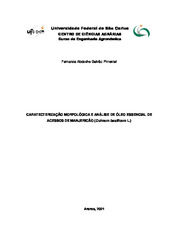| dc.contributor.author | Pimentel, Fernanda Abduche Galvão | |
| dc.date.accessioned | 2021-07-19T12:23:04Z | eng |
| dc.date.available | 2021-07-19T12:23:04Z | eng |
| dc.date.issued | 2021-06-25 | eng |
| dc.identifier.citation | PIMENTEL, Fernanda Abduche Galvão. Caracterização morfológica e análise de óleo essencial de acessos de manjericão (Ocimum basilicum L.). 2021. Trabalho de Conclusão de Curso (Graduação em Engenharia Agronômica) – Universidade Federal de São Carlos, Araras, 2021. Disponível em: https://repositorio.ufscar.br/handle/ufscar/14622. | * |
| dc.identifier.uri | https://repositorio.ufscar.br/handle/ufscar/14622 | por |
| dc.description.abstract | The basil (Ocimum basilicum L.) is a condiment widely used medicinally, aromatically, in the pharmaceutical and cosmetic industries through the extraction of its essential oils. The objective of this work was to carry out the morphological and physicochemical characterization of basil accesses from the Germplasm Bank of the Federal University of São Carlos. During the first stage of the experiment, agronomic characteristics of 63 accesses were evaluated. There was great variation in these characteristics between accesses, especially during the flowering period. Those with late flowering, some intermediates and with agronomic morphological characteristics of interest were evaluated, in the second stage in a hydroponic system of cultivation, analyzing agronomic characteristics of the plants and physicochemical characterization of the essential oils from 15 accesses, with two commercial varieties (Basil Manolo (T1) and Fine French Basil (T2)) and 13 accesses from the first stage. The essential oil contents found varied from 0.07 to 0.40%, and the most prominent volatile fraction was methyl-eugenol. However, the accesses that stood out were the G11 and G22 (G being the large typology), for presenting very interesting agronomic characteristics for the cultivation of basil in a hydroponic system, for the commercialization of the same in natura and the G24 for the extraction of essential oils. The commercial witnesses also evaluated in this project are even superior. Noting that there are new accesses with great potential to enter the consumer market. | eng |
| dc.language.iso | por | por |
| dc.publisher | Universidade Federal de São Carlos | por |
| dc.rights | Attribution-NonCommercial-NoDerivs 3.0 Brazil | * |
| dc.rights.uri | http://creativecommons.org/licenses/by-nc-nd/3.0/br/ | * |
| dc.subject | Óleo essencial | por |
| dc.subject | Florescimento | por |
| dc.subject | Condimentares | por |
| dc.subject | Sistema hidropônico | por |
| dc.subject | Características agronômicas | por |
| dc.title | Caracterização morfológica e análise de óleo essencial de acessos de manjericão (Ocimum basilicum L.) | por |
| dc.title.alternative | Morphological characterization and essential oil analysis of basil accesses | eng |
| dc.type | TCC | por |
| dc.contributor.advisor1 | Sala, Fernando César | |
| dc.contributor.advisor1Lattes | http://lattes.cnpq.br/6771975466075202 | por |
| dc.description.resumo | O manjericão (Ocimum basilicum L.) é um condimento amplamente utilizado de forma medicinal, aromática, na indústria farmacêutica e de cosméticos através da extração dos seus óleos essenciais. O objetivo do presente trabalho foi realizar a caracterização morfológica e físico-química de acessos de manjericão do Banco de Germoplasma da Universidade Federal de São Carlos. Durante a primeira etapa do experimento foram avaliados características agronômicas de 63 acessos. Houve grande variação destas características entre os acessos, principalmente para o período de florescimento. Aqueles com florescimento tardio, algumas intermediarias e com características morfológicas agronômicas de interesse foram avaliados, na segunda etapa em sistema hidropônico de cultivo, analisando características agronômicas das plantas e feita caracterização físico-química dos óleos essenciais de 15 acessos, sendo duas variedades comerciais (Manjericão Manolo (T1) E Manjericão Fino Francês (T2)) e 13 acessos da primeira etapa. Sendo que os teores de óleos essencial encontradas variaram de 0,07 a 0,40%, e a fração volátil de destaque foi o metil-eugenol. Contudo os acessos que se destacaram foram os G11 e G22 (sendo G referente a tipologia graúdo), por apresentarem características agronômicas bem interessante para cultivo do manjericão em sistema hidropônico, para a comercialização do mesmo in natura e o G24 para extração dos óleos essencial. Sendo até mesmo superior as testemunhas comerciais também avaliadas neste projeto. Observando assim que existem novos acessos com grande potencial para ingressar no mercado consumidor. | por |
| dc.publisher.initials | UFSCar | por |
| dc.subject.cnpq | CIENCIAS AGRARIAS::AGRONOMIA | por |
| dc.publisher.address | Câmpus Araras | por |
| dc.contributor.authorlattes | http://lattes.cnpq.br/6184216909164740 | por |
| dc.publisher.course | Engenharia Agronômica - EAg-Ar | por |

